(Remember, you can click on any photo to enlarge. Also don’t forget that the formatting of this blog post is better – everything lines up better – when you can read it online at www.ronf-flyingcolours.com – click on this link to go there. Also, if you’re logged into the post with your own userid, you can request an automatic update whenever a new blog post is put up – just click on the Subscribe link and enter your e-mail address. You cannot do this, though, if you’re logged in using the “friends” username.)
A neighbor at our marina in Anacortes prides himself with an early May departure each year for SE Alaska. He boasts of cruising straight through the 1,100+ miles, to get there in just over 6 days. When asked if he ever changes course or spend some time to see any sights along the way, he stares blankly back at us. At 12 kts cruising speed (14 mph), he (and his wife and dog) drive a relentless 12-14 hours a day, stopping only to anchor each night. His only interest is in reaching the fishing waters of SE Alaska, and seemingly doesn’t care one whit about the incredible scenery along the way. For him, the primary focus is being there to catch their winter’s supply of fish, crab, and prawns. Getting there is simply something that must be endured. Both husband and wife are in their late 70s, and their 60’ custom-built yacht was constructed and outfitted with this type of cruising in mind.
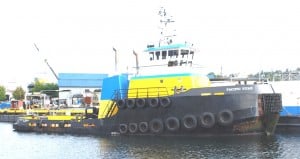
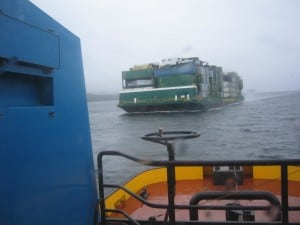 In 2003 and again in 2006, Kap and I cruised to SE Alaska aboard the 120’ Pacific Titan tugboat, towing a 300’ barge, departing from the Duwamish Waterway near downtown Seattle and not stopping until five days later at the five ports of call in SE Alaska. At 9 kts (10 mph) it was leisurely enough to watch the coastline pass by, but it wasn’t coastal cruising in the “let’s have fun getting there sense”. At Ketchikan, Petersburg, Juneau, Haines, and Skagway we had no more than two hours at each stop to browse around and even get a sense of being there. It was essentially like driving across the U.S., seeing all the sights out the window, but not even stopping for gas or bathroom breaks, and running straight through at night too. (In the photo above left, the Pacific Titan is tied up alongside the Western Towboat docks in the Seattle Ship Canal. Western Towboat adds a new towboat to their fleet year, building it right here in their shipyard as custom, one-off tugs. At right is the 300′ barge, with over 700 double-sized containers – about 75 of them refrigerated – hauling just about all of the supplies necessary to provision the towns in SE Alaska, where the only access is by water or air.)
In 2003 and again in 2006, Kap and I cruised to SE Alaska aboard the 120’ Pacific Titan tugboat, towing a 300’ barge, departing from the Duwamish Waterway near downtown Seattle and not stopping until five days later at the five ports of call in SE Alaska. At 9 kts (10 mph) it was leisurely enough to watch the coastline pass by, but it wasn’t coastal cruising in the “let’s have fun getting there sense”. At Ketchikan, Petersburg, Juneau, Haines, and Skagway we had no more than two hours at each stop to browse around and even get a sense of being there. It was essentially like driving across the U.S., seeing all the sights out the window, but not even stopping for gas or bathroom breaks, and running straight through at night too. (In the photo above left, the Pacific Titan is tied up alongside the Western Towboat docks in the Seattle Ship Canal. Western Towboat adds a new towboat to their fleet year, building it right here in their shipyard as custom, one-off tugs. At right is the 300′ barge, with over 700 double-sized containers – about 75 of them refrigerated – hauling just about all of the supplies necessary to provision the towns in SE Alaska, where the only access is by water or air.)
Then in 2008 we cruised to SE Alaska aboard our own boat, a Nordic Tug 42 named Cosmo Place (it was our second-ever year of cruising). With no set schedule to keep, we spent 15 days just getting from Anacortes to Ketrhikan, our first Alaskan port of call. This cruise easily ranks as one of our best ever summer holidays, and every single day of the adventure was exclusively about slow-boat cruising – and the art of getting there.
Since 2009, cruising on Flying Colours has always been the same – never really rushing to get anywhere. Sometimes we didn’t linger in places as long as we might have, but nevertheless it was leisurely. This year is starting out to be no different.
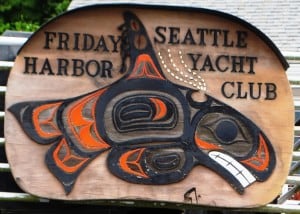
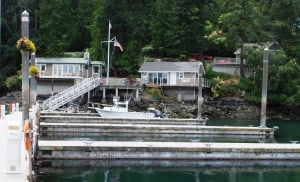
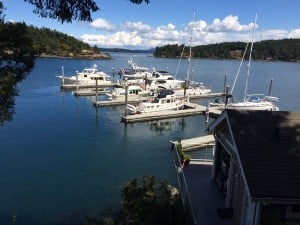 Departing Anacortes for Friday Harbor, Thursday, June 9.
Departing Anacortes for Friday Harbor, Thursday, June 9.
Since it was our first time away from the dock this year with Flying Colours, and since we’ve had various system problems for the past couple of years, the beginning few days were slated to be our shakedown cruise – just over to Friday Harbor on San Juan Island, a short two hour cruise to the Seattle Yacht Club outstation
The photo at left is a NW tribal art carving, carved and donated to the club by an SYC member. Every outstation has a unique carving standing at the head of the dock.
The middle photo shows the SYC outstation property from our moorage. The resident outstation manager hired by the SYC lives in the house at left. The building at right is a clubhouse where members can get together to tell tall tales, and in front of it is a deck with BBQs for summer evenings. Above the clubhouse is the outstation’s third building, containing a laundry room with three each of washers and dryers, and two shower/toilet rooms for member use.
The bottom photo is taken from the sidewalk on the way up to the laundry/shower building, looking back at the outstation dock. This was the day after our arrival, and there are 7-8 member boats moored there now. Looking above the boats is the southern entrance to Friday Harbor, and on a clear day there’s a magnificent view of Mt. Baker in the distance. The town and harbor of Friday Harbor is about a mile to the left, where there’s a Washington State Ferry dock with service to Anacortes and Sidney, B.C.
So far, so good. Our only known problems are a fresh water pump that failed over the winter, with a replacement pump that hasn’t yet been fully installed, and our WhisperGen to charge the house bank batteries is regularly coming up with a fault indicator. If necessary, we’ll have both problems sorted out in Sidney while we’re provisioning.
The Friday Harbor outstation is one of our favorites – where we usually get a side-tie moorage on the end dock. It was almost deserted when we arrived, but by the next day it was almost full, with a daily flow of cruisers leaving on their summer adventures and others arriving. Flying Colours is the far left boat on the furthest dock from shore.
The biggest unknown of the shakedown was to see how the three pets would work out on the cruise. Our original plan throughout the winter had been to leave Gator and ZuZu home with a pet sitter, but not knowing how long before we’d have to say goodbye forever to either, we’d made the decision that they’d be with us this year – turning this into the summer of pet duty.
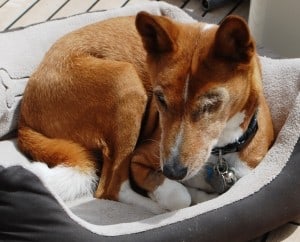 Gator has been aboard many times and is an old salt at cruising, but with his recent left eye removal, plus his advanced age of almost 17 makes his summer aboard Flying Colours somewhat problematic. Getting from almost anywhere to anywhere else on the boat involves going up or down fairly steep stairs, and we’ve seen his balance and leg strength seriously deteriorate over the past couple of years. It also involves watching out for treacherous, sharp, pokey things almost every minute, and not yet being used to having only a right eye for peripheral vision means he constantly bangs into and trips over things. He’s surprising us, though, and we can see daily improvement in just how well he adapts to it. Our biggest concern is how he’ll manage the “going ashore to do his business” duties – and later, how we’ll manage all this at anchor when going ashore is a dinghy ride to a rock-studded beach in the Broughton’s.
Gator has been aboard many times and is an old salt at cruising, but with his recent left eye removal, plus his advanced age of almost 17 makes his summer aboard Flying Colours somewhat problematic. Getting from almost anywhere to anywhere else on the boat involves going up or down fairly steep stairs, and we’ve seen his balance and leg strength seriously deteriorate over the past couple of years. It also involves watching out for treacherous, sharp, pokey things almost every minute, and not yet being used to having only a right eye for peripheral vision means he constantly bangs into and trips over things. He’s surprising us, though, and we can see daily improvement in just how well he adapts to it. Our biggest concern is how he’ll manage the “going ashore to do his business” duties – and later, how we’ll manage all this at anchor when going ashore is a dinghy ride to a rock-studded beach in the Broughton’s.
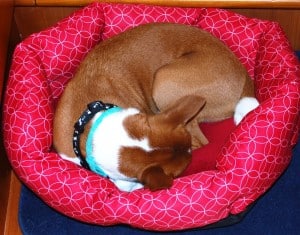 This is Jamie’s first-ever time on the water, so while she’s a complete unknown, she’s also extremely smart and quick to pick up on everything. Before we even get away, we could tell immediately she was going to take very well to this.
This is Jamie’s first-ever time on the water, so while she’s a complete unknown, she’s also extremely smart and quick to pick up on everything. Before we even get away, we could tell immediately she was going to take very well to this.
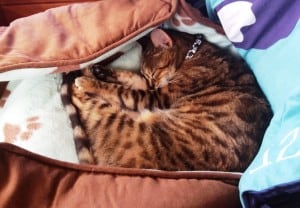 ZuZu is the most worrisome unknown this year, and in several ways the biggest problem on the boat. Being an indoor/outdoor cat all her life and always spending lots of time outside and on the hunt at home, she really likes her freedom – but well-chaperoned dock walks on a leash are all that we can risk with her. The big hassle with ZuZu, though, is her cat box, and her rather messy usage of it when she’s under stress. Kap goes to great lengths to set up the guest head as “ZuZu’s head”, with the shower stall completely lined with black garbage bags to contain the kitty litter that gets thrown about, and the floor lined wall-to-wall with big incontinence pads. And (pardon the impropriety of this) when she’s really stressed, she half-misses her box with “two’s”, and does her “one’s” on the incontinence pads. Sure enough, the first few days out, ZuZu was stressed out, making Kap equally stressed out as ZuZu’s mistakes have to be cleaned up. We’ve since started her on some vet-recommended stress-relieving pills, and their effectiveness has been amazing.
ZuZu is the most worrisome unknown this year, and in several ways the biggest problem on the boat. Being an indoor/outdoor cat all her life and always spending lots of time outside and on the hunt at home, she really likes her freedom – but well-chaperoned dock walks on a leash are all that we can risk with her. The big hassle with ZuZu, though, is her cat box, and her rather messy usage of it when she’s under stress. Kap goes to great lengths to set up the guest head as “ZuZu’s head”, with the shower stall completely lined with black garbage bags to contain the kitty litter that gets thrown about, and the floor lined wall-to-wall with big incontinence pads. And (pardon the impropriety of this) when she’s really stressed, she half-misses her box with “two’s”, and does her “one’s” on the incontinence pads. Sure enough, the first few days out, ZuZu was stressed out, making Kap equally stressed out as ZuZu’s mistakes have to be cleaned up. We’ve since started her on some vet-recommended stress-relieving pills, and their effectiveness has been amazing.
 Friday Harbor to Sidney (B.C.), Monday, June 13th.
Friday Harbor to Sidney (B.C.), Monday, June 13th. 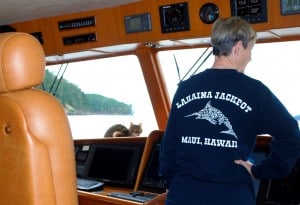 For some reason, getting our last-minute cruising chores done at Friday Harbor seems preferable to being at our home slip – I suppose it’s something about having actually gotten underway. Anyway, after three days of leisurely effort, we felt ready to head out for the rest of the summer and shoved off from Friday Harbor.
For some reason, getting our last-minute cruising chores done at Friday Harbor seems preferable to being at our home slip – I suppose it’s something about having actually gotten underway. Anyway, after three days of leisurely effort, we felt ready to head out for the rest of the summer and shoved off from Friday Harbor.
It’s a quick and easy 2½ hour cruise to Sidney, but it’s always a bit stressful, mainly due to clearing Customs. Since we started cruising in 2007 we’ve done the border crossing on the water at least two dozen times each direction, and while our Nexus cards make it super easy, there’s always the unknown of getting a persnickety Customs agent who’s having a hard day and just wants to make things difficult. Making matters worse, the rules for food, alcohol, and others items that might need to be declared are changing all the time and it’s really difficult to know what’s allowed or not allowed for any crossing.
After many years of anxiety I think we finally have the alcohol situation figured out – with a nifty term called “ship’s stores”. I keep a detailed Excel spreadsheet of every bottle of alcohol on board, updating it with a percent full notation (so it if’s a fifth of vodka – i.e., a 750 ml bottle, and half full – my spreadsheet shows it as 750 x .5, or 350 ml). The spreadsheet then tallies it up, and when asked by Customs how much alcohol we have on board, I can say (without hesitation), “our normal ship’s stores, and for this crossing we have 18 bottles – all open – and a total of 5½ liters across all of them”. This has worked beautifully for several years, and we’ve never been questioned beyond that.
For food, things between the U.S. and Canada are becoming more lax every year. We can now bring most produce back and forth without problem, including citrus, vegetables, and herbs (all of which were not allowed just a few years ago).
Meat is the interesting question – you can now bring something like 25 lbs per person, but it must be in the original store wrapping, listing country of origin, and the sales receipt. For us, that’s huge, as Kap really prefers beefalo for her BBQ steaks, and I now provision from home with a full beefalo tenderloin, cut by the butcher into about a dozen 5 oz steaks. I’m partial to 8 oz prime New York steaks, so I order the same number of them. I have the butcher separate all the steaks inside a single package with special butcher’s black plastic liner that allows them to be later separated. Right after purchase I freeze them at home in their original wrapping, and on arrival in Canada I separate them (still frozen) and vacuum seal them individually for use during our cruise.
Our NEXUS clearance this time was a non-event. After giving the Canada Customs guy our “boat number” – which is a number assigned when we first crossed in 2009 – I then gave him both of our NEXUS numbers. He asked if we had any firearms or alcohol on board, and if we had over C$10,000 in cash aboard the boat. I gave my regular spiel about ship’s stores, with no problems. Almost as an afterthought (and most likely because it’s in our computer record) he asked if we had any pets on board – information which I hadn’t offered, as I only speak when spoken to in situations such as this – and I told him of the two dogs and a cat, all three entering with complete shot records. After that he gave me an 11-digit “Canada Clearance Number” that I then print out and tape to a salon window. The call was over in less than five minutes, and we were back in Canada.
By 1PM we were safely tied up at our assigned slip at Port Sidney Marina for a 4-night stay.
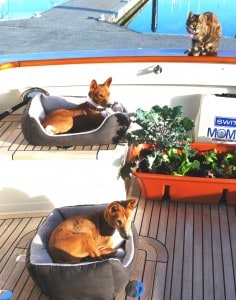 We always rent a car in Sidney – one of the reasons being to pick up three planter boxes of herbs and greens that we grow in the cockpit throughout the summer’s cruise. We got mostly kale, lettuce, and basil for salad fixin’s . . . also some potted grass and catnip for the dogs and ZuZu to snack on.
We always rent a car in Sidney – one of the reasons being to pick up three planter boxes of herbs and greens that we grow in the cockpit throughout the summer’s cruise. We got mostly kale, lettuce, and basil for salad fixin’s . . . also some potted grass and catnip for the dogs and ZuZu to snack on.
A special mechanic visit to the dock got two maintenance issues taken care of in record time. Our third system glitch would plague us throughout the entire cruise – our DISH TV antenna, and after Kap spent hours and hours trying to resolve the problem with their tech support, the conclusion was that they’d changed something about their satellites in the past year, and our 2009 system (that costs upwards of $10,000 to replace) is not upgradeable – and we couldn’t even look into a replacement until this fall after we get back to Anacortes.
The rest of our Sidney stay was mostly R&R that was badly needed. We got a much needed fix of pork schnitzel at the Bistro Suisse in downtown Sidney, plus an absolutely wonderful lunch of local prawns sautéed in a Sambuca and butter sauce at the Stonehouse Pub a few miles north of town at Canoe Cove.
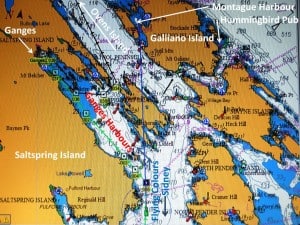
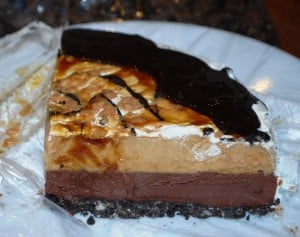 Sidney to Ganges, Saturday, June 18. You definitely need to click on the navigation chartplotter map at left to see the notes I added to it for reference. The little green boat symbol at the middle left shows Flying Colours chugging up the SE corner of Saltspring Island, just before turning left into Ganges Harbour. The harbour is about five miles deep, with the quaint little town of Ganges at the head of the harbour.
Sidney to Ganges, Saturday, June 18. You definitely need to click on the navigation chartplotter map at left to see the notes I added to it for reference. The little green boat symbol at the middle left shows Flying Colours chugging up the SE corner of Saltspring Island, just before turning left into Ganges Harbour. The harbour is about five miles deep, with the quaint little town of Ganges at the head of the harbour.
We always moor at the Ganges Marina, as it’s close to town and easy to take the dogs for their “duty” walks on shore. The Seattle Yacht Club has an outstation that’s shared with a commercial marina, but it’s an extra mile walk to town, and the disheveled old docks are in such bad shape that walking on them is hazardous – so we shy away from it after staying there once several years ago.
Kap had an extra special reason to visit Ganges – to pick up an absolutely delicious frozen gelato cake from a hole-in-the-wall ice cream and gelato place. We discovered it last year for Kap’s brother’s birthday (when Elliot and Michele joined us for a quick week’s cruise in the Gulf Islands). Kap decided she needed it this year for her own month’s-ago birthday. The little shop is called Harlan’s, and the particular cake that Kap likes is Galliano (named after the nearby island). It’s wickedly decadent, and so rich that it’s hard to eat very much at a time. With a whole cake to ourselves, Kap cut it into fourths, wrapped each in Saran wrap and froze them. For the next month we had small sliver slices for dessert on nights when we wanted to splurge.
Ganges is one of our favorite Gulf Island stopovers, but it’s lost one of the primary reasons – the privately-owned liquor store called The Local where each year we’ve provisioned with top-flight B.C. wine . . . it’s been sold, and no longer carries the good stuff.
After picking up her frozen gelato cake, we headed north the next morning for Ovens Island and a hoped-for couple of days of seclusion at this tiny island that’s owned by the Seattle Yacht Club.
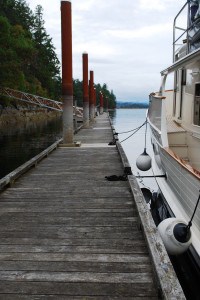 Ganges to Ovens Island, Sunday, June 19. On any cruise in or out of Ganges, it always seems like the longest part of it is in Ganges Harbour. Part of that is due to a long, shallow no-wake zone, where floating navigational buoys clearly mark a speed limit of 5 knots. You’re always dodging crab pots that are devilishly colored to be near invisible on the water’s surface. And being a busy harbor there are always sailboats tacking back and forth and power boats speeding in and out, ignoring the no-wake signs. But finally we’re back in ;lkj Passage, and with a sweeping 180° turn to port we’re in ;lkj Channel and headed past the west side of Galliano Island. It’s less than three hours to Ovens Island. It’s surprising how little other cruising traffic we meet or pass along the way, giving us hope that no one else will be at the dock on Ovens Island when we arrive.
Ganges to Ovens Island, Sunday, June 19. On any cruise in or out of Ganges, it always seems like the longest part of it is in Ganges Harbour. Part of that is due to a long, shallow no-wake zone, where floating navigational buoys clearly mark a speed limit of 5 knots. You’re always dodging crab pots that are devilishly colored to be near invisible on the water’s surface. And being a busy harbor there are always sailboats tacking back and forth and power boats speeding in and out, ignoring the no-wake signs. But finally we’re back in ;lkj Passage, and with a sweeping 180° turn to port we’re in ;lkj Channel and headed past the west side of Galliano Island. It’s less than three hours to Ovens Island. It’s surprising how little other cruising traffic we meet or pass along the way, giving us hope that no one else will be at the dock on Ovens Island when we arrive.
Our next stop was Ovens Island – the whole island owned by the Seattle Yacht Club, and named after an SYC couple (Robert and JoAnne Ovens) who purchased and donated it to the SYC to make it into an outstation. Ovens island is along the north shore of Ladysmith Harbour, a 3-mile long harbour that juts into the coastline of Vancouver Island.
As we rounded the eastern tip of Ovens Island and could start to see the dock, it appeared empty . . . but then a small 26’ fast boat was sighted in the middle of the dock. We figured it was probably the caretaker doing his daily check of the island, as this is usually too far north for SYC cruisers in that small of a boat. But when we trained our binoculars on it an SYC burgee, and as our bow cleared the east end of the dock a young guy stepped off the boat to catch our lines. Soon his wife joined us on the dock and we learned they are brand new SYC members, with a summer goal of visiting every one of the eleven SYC outstations on two or three quick cruises they’ll make during the summer. On this cruise they had visited five outstations, and after only an hour at Ovens Island they were headed south for home. It sounded like a nice introduction to the club.
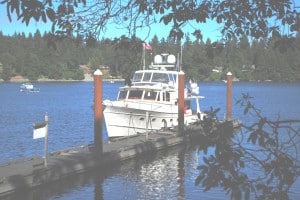
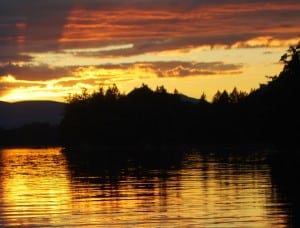 To our surprise, they departed a few minutes after our arrival, giving us the rest of the day and all of the next to ourselves on the island, with private access to walk Gator and Jamie on the island. Sometimes we’re able to let them off leash, but this time they persisted in scrounging up bits of nasty-looking stuff (most likely rodent carcasses) and they had to be on leash. ZuZu made at least a dozen off-boat dashes down the dock before we could catch her and bring her back on board, but twice she made it onto the island. Luckily the island’s only about two acres in total size and you can walk the perimeter in about 10 minutes, so finding her in the dense wooded areas isn’t all that difficult. Nevertheless, there has been a raccoon family on the island in the past, and we’re never sure if they’re still there or permanently gone.
To our surprise, they departed a few minutes after our arrival, giving us the rest of the day and all of the next to ourselves on the island, with private access to walk Gator and Jamie on the island. Sometimes we’re able to let them off leash, but this time they persisted in scrounging up bits of nasty-looking stuff (most likely rodent carcasses) and they had to be on leash. ZuZu made at least a dozen off-boat dashes down the dock before we could catch her and bring her back on board, but twice she made it onto the island. Luckily the island’s only about two acres in total size and you can walk the perimeter in about 10 minutes, so finding her in the dense wooded areas isn’t all that difficult. Nevertheless, there has been a raccoon family on the island in the past, and we’re never sure if they’re still there or permanently gone.
An almost never-fail treat of our stopovers at Ovens Island are the sunsets. The angle of the island, pointing almost due west at our position on the dock, is perfect for catching wonderful sunset photos. For some reason they come out a brilliant copper color, and this photo is totally untouched with Photoshop.
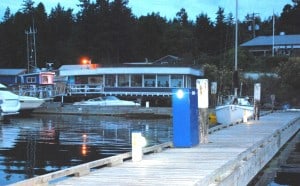 Ovens Island to Silva Bay Marina, Tuesday, June 21. ;lkj
Ovens Island to Silva Bay Marina, Tuesday, June 21. ;lkj
Silva Bay is a very protected bay on the SE corner of Gabriola Island, about 20 miles north of Ovens Island, and makes an excellent jump-off point to head across the wide expanse of the Strait of Georgia.
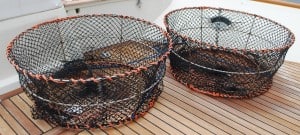
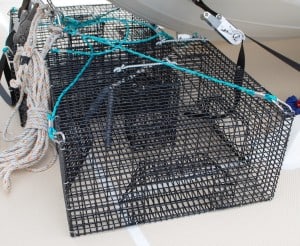 But the real reason for an overnight stop at Silva Bay Marina was to purchase new prawn traps that are made by a guy who works at the small shipyard next door to the marina. We’d heard about these from an SYC friend at Friday Harbour, who swears by these after using them for a season. They are less than half the size of our current traps – 18” rectangular versus 30” round, and weigh less than half. Our current traps have a heavy thread mesh, and while we have no idea how many prawns escape through the mesh when the trap is on the bottom, we know from seeing a few escape as we pull it to the surface. The new traps are a much smaller welded metal mesh, and are too small for the prawns to escape through. The size and weight, though, were the big factors, as we’ve concluded that a larger dinghy simply won’t fit on our boat’s dinghy deck – it’s currently an 11’-6” inflatable RIB dinghy, and we were hoping to get a 13’ hard-sided (and thin walled) Whaler dinghy, but that isn’t going to happen. The current prawn traps are a bugaboo to handle during setting and retrieval, so we hope these solve the problem.
But the real reason for an overnight stop at Silva Bay Marina was to purchase new prawn traps that are made by a guy who works at the small shipyard next door to the marina. We’d heard about these from an SYC friend at Friday Harbour, who swears by these after using them for a season. They are less than half the size of our current traps – 18” rectangular versus 30” round, and weigh less than half. Our current traps have a heavy thread mesh, and while we have no idea how many prawns escape through the mesh when the trap is on the bottom, we know from seeing a few escape as we pull it to the surface. The new traps are a much smaller welded metal mesh, and are too small for the prawns to escape through. The size and weight, though, were the big factors, as we’ve concluded that a larger dinghy simply won’t fit on our boat’s dinghy deck – it’s currently an 11’-6” inflatable RIB dinghy, and we were hoping to get a 13’ hard-sided (and thin walled) Whaler dinghy, but that isn’t going to happen. The current prawn traps are a bugaboo to handle during setting and retrieval, so we hope these solve the problem.
To get to Silva Bay from Ovens Island requires transit of Gabriola Passage, a narrow and shallow channel that separates the southern tip of Gabriola Island from Valdes Island. The tide can run as high as 8 knots at full flood or ebb (and we typically cruise at 9-10 knots), so timing this passage at slack tide is very important. The passage itself has multiple S-turns, and a fragile shoreline requires a slow passage through it.
Kap timed the cruise north from Ovens Island to match a midday slack time, allowing for us to slow down to pump out our black water tank at the deepest part of Stuart Channel. We then ran our watermaker for the remainder of the morning’s cruise, not knowing if there was potable fresh water available on the marina’s dock.
Gabriola Passage proved to be a non-event, and winding our way through the Flat Top Islands outside Silva Bay, we arrived at the marina a few minutes after noon. We’d heard good reports about their marina café that overlooks the docks (it’s the building with large glass windows at the head of the dock in the photo above), but it was closed for some kind of repairs. Bummer!
At the little private liquor store behind the café, Kap stumbled onto a major find – several flavors of Rekorderlig hard cider that she really likes. Kap and Lisa Hart came across this Swedish-made cider during our narrowboat canal trip in England last September, and haven’t come across it anywhere in the U.S. But here it was in this tiny little liquor store in a marina in Silva Bay. They didn’t have the plain apple hard cider, so she bought out the entire stock of the spiced apple flavor – which is just about as good.
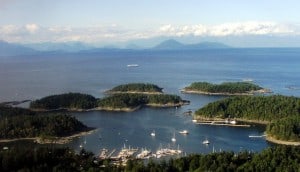 Silva Bay Marina to Garden Bay SYC outstation, Wednesday, June 22.
Silva Bay Marina to Garden Bay SYC outstation, Wednesday, June 22.
The weather report for crossing the Strait of Georgia was for calm winds and small seas in the morning, but starting to kick up in the early afternoon – so Kap decided we should get an early start for the 30+ mile crossing of this large expanse of water between Vancouver Island and the mainland. The actual crossing distance is only 14 miles (the narrowest point of the Strait), but we’d be crossing at an oblique angle.
The photo at left is pointing almost exactly at our course. Silva Bay Marina is at the bottom, and we have to wind our way out of the Flat Top Islands to reach the open water of the Strait of Georgia. The large-ish boat above the islands is a B.C. ferry heading for Vancouver from Nanaimo. There are two low mountains in the top center that lie in the middle of the Strait of Georgia (Lasqueti on the left and Texada on the right). We’re heading just to the right of Texada, and a few miles beyond the southern tip of it we’ll turn right into Pender Harbour on the B.C. mainland coast.
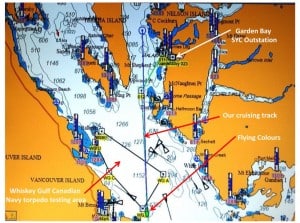 Always a concern crossing the Strait of Georgia is whether Whiskey Gulf (WG) – the Canadian Navy torpedo testing area – is OK to cross. This trapezoidal-shaped area on the western side of the Strait is in our cruising track for almost every crossing we make, as our transit from the south is along the east side of Vancouver Island, and it doesn’t matter where our next destination is, WG will affect us. If we’re staying on the west side of the Strait towards Comox, we’ll have to pass by WG in a very narrow passage along the edge of it, with quite shallow water on the other side of the passage (next to the dark blue area on the chart above). If we’re heading for the SYC outstation at Garden Bay (in Pender Harbour) on the east side, our track is right through it. If WG is “active” with torpedo tests, there will be Navy ships patrolling the perimeter, and if they even get a hint that a private vessel is entering the test zone all hell breaks loose. It’s imperative that all boaters check the marine radio frequency that announces whether WG is open and active, or closed and OK to cross. This day it was closed and OK to cross, which saved us from skirting around the southeastern corner of it.
Always a concern crossing the Strait of Georgia is whether Whiskey Gulf (WG) – the Canadian Navy torpedo testing area – is OK to cross. This trapezoidal-shaped area on the western side of the Strait is in our cruising track for almost every crossing we make, as our transit from the south is along the east side of Vancouver Island, and it doesn’t matter where our next destination is, WG will affect us. If we’re staying on the west side of the Strait towards Comox, we’ll have to pass by WG in a very narrow passage along the edge of it, with quite shallow water on the other side of the passage (next to the dark blue area on the chart above). If we’re heading for the SYC outstation at Garden Bay (in Pender Harbour) on the east side, our track is right through it. If WG is “active” with torpedo tests, there will be Navy ships patrolling the perimeter, and if they even get a hint that a private vessel is entering the test zone all hell breaks loose. It’s imperative that all boaters check the marine radio frequency that announces whether WG is open and active, or closed and OK to cross. This day it was closed and OK to cross, which saved us from skirting around the southeastern corner of it.
As you can see in our chartplotter image above, WG is in the deepest part of the Strait – where the average depth is upwards of 1,200’ (almost ¼ mile deep) – plenty of deep water for submarines to play around, shooting off test torpedoes . . . or whatever. The U.S. Navy tests here a lot – and maybe they’re the primary users of this test area, as I don’t think the Canadians have a lot of submarines). We also don’t have such deep waters further south in Puget Sound, so for all I know, this whole testing zone might have been established primarily by the U.S. Navy. It’s all hush-hush, and there isn’t much information available about it.
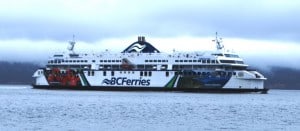 Also in the chartplotter image are several white with black border triangles scattered about, each with a direction of travel line extending off the point. Those are other boats around us that transmit AIS signals, usually indicating they are commercial vessels. The one to the right of Flying Colours is the B.C. ferry that I photographed as it went by. These are behemoth ferries, and the wake they put out can be enormous. This one is travelling between Nanaimo (on Vancouver Island) and the Half Moon Bay terminal, one of the two ferry terminals that service Vancouver.
Also in the chartplotter image are several white with black border triangles scattered about, each with a direction of travel line extending off the point. Those are other boats around us that transmit AIS signals, usually indicating they are commercial vessels. The one to the right of Flying Colours is the B.C. ferry that I photographed as it went by. These are behemoth ferries, and the wake they put out can be enormous. This one is travelling between Nanaimo (on Vancouver Island) and the Half Moon Bay terminal, one of the two ferry terminals that service Vancouver.
It was a medium-long day (for us) to Garden Bay – around six hours – and we arrived early afternoon. We were hoping for a quiet and peaceful stay at this favorite SYC outstation, and our arrival didn’t disappoint us – only two other member boats on the docks when we arrived, and we pretty much had our pick of the best dock space.
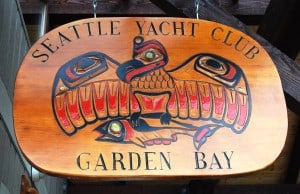 The outstation is at the deepest part of the meandering bay inside Pender Harbour. It’s also one of the crown jewels in the SYC outstation system, managed and taken care of by two really special people (Vera and Vladimir) who have been there for 23 years. They keep the place spotless, with all facilities in absolute first-class condition, the clubhouse is impeccable shape, and flowers and manicured grounds everywhere ashore. Vera is always on the dock to take the mooring lines of every member boat that enters, and she always fills us in with the latest news of the area. Directly across the inner bay is the Royal Vancouver Yacht Club, and since the SYC and RVYC have a close relationship there’s a lot of cross-communication among members.
The outstation is at the deepest part of the meandering bay inside Pender Harbour. It’s also one of the crown jewels in the SYC outstation system, managed and taken care of by two really special people (Vera and Vladimir) who have been there for 23 years. They keep the place spotless, with all facilities in absolute first-class condition, the clubhouse is impeccable shape, and flowers and manicured grounds everywhere ashore. Vera is always on the dock to take the mooring lines of every member boat that enters, and she always fills us in with the latest news of the area. Directly across the inner bay is the Royal Vancouver Yacht Club, and since the SYC and RVYC have a close relationship there’s a lot of cross-communication among members.
Later in July and August when things get busy and two dozen boats are moored at the docks, there’s always a Happy Hour at the clubhouse patio, and every boater brings their drinks and an appetizer. With 3,000+ total SYC members – where it’s impossible to know everyone – this is a really good way to get to know other club members who are out on the water.
The plan was to hang out for several days at Garden Bay, resting up and adding provisions from an excellent supermarket at the small town of Madeira Park, a short dinghy ride away within Pender Harbour. We departed Garden Bay on Sunday, June 26th, so that gave us a good four days of R&R.
Endnote. This only takes us up to June 22, and here it is July 10th before I can get our travel saga uploaded. We’ve been in some quite remote waters for the past couple of weeks, without cell coverage or WiFi access most of the time. Even when we did have access, it was painfully slow – so slow that it would take 2-3 minutes to load a single internet page, and that makes it impossible to work with WordPress on getting a post ready to go. I’ll keep plugging away at it, and hopefully get up to date with our travels.
